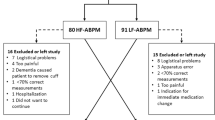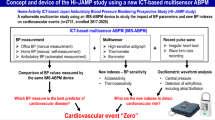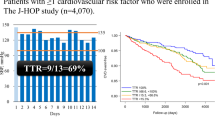Abstract
The objective of the study was to evaluate the efficacy of device-guided breathing to lower blood pressure (BP) in hypertensive type II diabetic patients. A randomized controlled trial was carried out in four urban family practice clinics in Israel. Non-insulin-dependent diabetic, hypertensive patients with uncontrolled BP, receiving antihypertensive therapy or those non-medicated were enrolled. Baseline characteristics of the 66 patients who completed the study (33 intervention and 33 control) were: 62% men, age 62±8 years (mean±s.d.); body mass index 29±5 kg/m2; systolic BP 148±11 mm Hg and diastolic BP 81±9 mm Hg. The intervention group used a device (RESPeRATE), which interactively guides the user towards slow and regular breathing by synchronizing respiration voluntarily to musical tones for 15 min daily for an 8-week period. The control group continued with their regular treatment. BP was measured in the clinic at baseline, after 4 weeks and at 8 weeks. Medication was unchanged for 4 weeks prior to and during the study period. The main outcome measure was the office BP change from baseline to the end of the 8-week period. BP was reduced in the treatment group (mean±s.e.) systolic −10.0±1.8 mm Hg and diastolic −3.6±1.3 mm Hg (P<0.0001 and P<0.01), but not in the controls +1.6±2.1 and −1.0±1.4 mm Hg P>0.4 and P>0.4, respectively. Test for between group difference P<0.0001 and P=0.08. The subjects were highly compliant with the treatment, performing 75% of the requested exercise sessions. Greater BP reduction was observed with increased compliance with device usage (P=0.01 and P=0.001). It is concluded that self-treatment with device-guided breathing at home for 8 weeks by non-insulin-dependent diabetic patients was associated with a substantial reduction in office systolic BP.
This is a preview of subscription content, access via your institution
Access options
Subscribe to this journal
Receive 12 digital issues and online access to articles
$119.00 per year
only $9.92 per issue
Buy this article
- Purchase on Springer Link
- Instant access to full article PDF
Prices may be subject to local taxes which are calculated during checkout


Similar content being viewed by others
References
The Hypertension in Diabetes Study Group. 1. Prevalence of hypertension in newly presenting type 2 diabetic patients and the association with risk factors for cardiovascular and diabetic complications. Hypertension in Diabetes Study (HDS). J Hypertension 1993; 11: 309–317.
Epstein M, Sowers JR . Diabetes mellitus and hypertension. Hypertension 1992; 19: 403–418.
Fuller JH . Epidemiology of hypertension associated with diabetes mellitus. Hypertension 1985; 7 (6 Part 2): II3–II7.
Bild D, Teutsch SM . The control of hypertension in persons with diabetes: a public health approach. Public Health Rep 1987; 102: 522–529.
Klein R, Klein BE, Moss SE, Davis MD, DeMets DL . Is blood pressure a predictor of the incidence or progression of diabetic retinopathy? Arch Intern Med 1989; 149: 2427–2432.
Hasslacher C, Ritz E, Terpstra J, Gallasch G, Kunowski G, Rall C . Natural history of nephropathy in type 1 diabetes: relationship to metabolic control and blood pressure. Hypertension 1985; 7 (6 Part 2): II74–II78.
Working Group Report on Hypertension in Diabetes. National High Blood Pressure Education Program. National Institutes of Health: Bethesda, MD, 1994; NIH publication no. 94-3530.
Chobanian AV, Bakris GL, Black HR, Cushman WC, Green LA, Izzo Jr JL et al. Seventh report of the Joint National Committee on Prevention, Detection, Evaluation, and Treatment of High Blood Pressure. Hypertension 2003; 42: 1206–1252.
Guidelines Committee. 2003 European Society of Hypertension—European Society of Cardiology guidelines for the management of arterial hypertension. J Hypertension 2003; 21: 1011–1053.
American Diabetes Association. Standards of medical care in diabetes. Diabetes Care 2005; 29: S4–S36.
UK Prospective Diabetes Study Group. Tight blood pressure control and risk of macrovascular and microvascular complications in type 2 diabetes. BMJ 1998; 317: 703–713.
Hansson L, Zanchetti A, Carruthers SG, Dahlof B, Elmfeldt D, Stevo J et al. Effects of intensive blood-pressure lowering and low-dose aspirin in patients with hypertension: principal results of the Hypertension Optimal Treatment (Hot) randomized trial. Lancet 1998; 351: 1755–1762.
Basile JN, Lackland DT, Basile JM, Riehle JE, Egan BM . A statewide primary care approach to cardiovascular risk factor control in high-risk diabetic and nondiabetic patients with hypertension. J Clin Hypert 2004; 6: 18–25.
Vermeire E, Hearnshaw H, Van Royen P, Denekens J . Patient adherence to treatment: three decades of research. A comprehensive review. J Clin Pharm Ther 2001; 26: 331–342.
Bengtsson C, Blohme G, Lapidus L, Lindquist O, Lundgren H, Nystrom E et al. Do antihypertensive drugs precipitate diabetes? BMJ 1984; 289: 1495–1497.
Schein MH, Gavish B, Herz M, Rosner-Kahana D, Naveh P, Knishkowy B et al. Treating hypertension with a device that slows and regularizes breathing: a randomized, double-blind controlled study. J Hum Hypertens 2001; 15: 271–278.
Grossman E, Grossman A, Schein MH, Zimlichman R, Gavish B . Breathing control lowers blood pressure. J Hum Hypertens 2001; 15: 263–269.
Rosenthal T, Alter A, Peleg E, Gavish B . Device-guided breathing exercises reduce blood pressure: ambulatory and home measurements. Am J Hypertens 2001; 14: 74–76.
Viskoper R, Shapira I, Priluck R, Mindlin R, Chornia L, Laszt A et al. Non-pharmacological treatment of resistant hypertensives by device-guided slow breathing exercises. Am J Hypertension 2003; 16: 484–487.
Elliott WJ, Izzo JL, White WB, Rosing DJ, Snyder CS, Alter A et al. Graded blood pressure reduction in hypertensive outpatients associated with use of a device to assist with slow breathing. J Clin Hypertens 2004; 6: 553–561.
Meles E, Giannattasio C, Faila M, Gentile G, Capra A, Mancia G . Non-pharmacologic treatment of hypertension by respiratory exercise in the home setting. Am J Hypertens 2004; 17: 370–374.
Elliott WJ, Izzo Jr JL . Device-guided breathing to lower blood pressure: case report and clinical overview. MedGenMed 2006; 8: 23 (www.medscape.com/viewarticle/539099).
Logtenberg SJ, Kleefstra N, Houweling ST, Groenier KH, Bilo HJ . Effect of device-guided breathing exercises on blood pressure in hypertensive patients with type 2 diabetes mellitus: a randomized controlled trial. J Hypertens 2007; 25: 241–246.
Simon RM . Design and analysis of therapeutic equivalence trials. In: Geller NL (ed). Advances in Clinical Trials Biostatistics. Marcel Dekker: New York, 2004, pp 53–66.
Gavish B . Device-guided slow breathing as a nonpharmacological approach to antihypertensive treatment in type 2 diabetics. J Hypertens 2007; 25: 1742.
Rogers MAM, Small D, Buchan DA, Butch CA, Stewart CM, Krenzer BE et al. Home monitoring service improves mean arterial pressure in patients with essential hypertension: a randomized controlled trial. Ann Intern Med 2001; 134: 1024–1032.
Dengel DR, Galecki AT, Hagberg JM, Pratley RE . The independent and combined effects of weight loss and aerobic exercise on blood pressure and oral glucose tolerance in older men. Am J Hypertens 1998; 11: 1405–1412.
Hollies S, Campbell F . What is meant by intention to treat analysis. Survey of published randomized controlled trials. BMJ 1999; 319: 670–674.
Blackwelder WC . Equivalence trials. In: Armitage P, Colton T (eds). Encyclopedia of Biostatistics, vol. 2, John Wiley: Chichester, 1998, pp 1367–1372.
Moran A, Palmas W, Field L, Bhattarai J, Schwartz JE, Weinstock RS et al. Cardiovascular autonomic neuropathy is associated with microalbuminuria in older patients with type 2 diabetes. Diabetes Care 2004; 27: 972–977.
Wirta OR, Pasternack AI, Mustonen JT, Laippala PJ, Reinikainen PM . Urinary albumin excretion rate is independently related to autonomic neuropathy in type 2 diabetes mellitus. J Intern Med 1999; 245: 329–335.
Bae JH, Kim JH, Choe K-H, Hong SP, Ko JK, Kim CH et al. Effect of device-guided breathing exercise on blood pressure control: Korean multi-center study. Korean Hyperten J 2006; 1: 19–23 (in Korean).
de Daly MB . Interactions between respiration and circulation. In: Cheniack NS, Widdicombe JG (eds). Handbook of Physiology. American Physiological Society: Bethesda, 1986, pp 529–594.
Eckberg DL, Kifle YT, Roberts VL . Phase relationship between normal human respiration and baroreflex responsiveness. J Physiol 1980; 304: 489–502.
Eckberg DL, Nerhed C, Wallin BG . Respiratory modulation of muscle sympathetic and vagal cardiac outflow in man. J Physiol 1985; 365: 181–196.
Parati G, Izzo Jr JL, Gavish B . Respiration and blood pressure. In: Izzo JL, Black HR (eds). Hypertension Primer, 3rd edn, Lippincott, Williams, and Wilkins: Baltimore, 2003, pp 117–120.
Goso Y, Asanoi H, Ishise H, Kameyama T, Hirai T, Nozawa T et al. Respiratory modulation of muscle sympathetic nerve activity in patients with chronic heart failure. Circulation 2001; 104: 418–423.
Bernardi L, Porta C, Spicuzza L, Bellwon J, Spadacini G, Frey AW et al. Slow breathing increases arterial baroreflex sensitivity in patients with chronic heart failure. Circulation 2002; 105: 143–145.
Parati G, Carretta R . Device-guided slow breathing as a non-pharmacological approach to antihypertensive treatment: efficacy, problems and perspectives. J Hypertens 2007; 25: 57–61.
Staessen JA, Thijs L, Bieniaszewski L, O’Brian ET, Palatini P, Davidson C . Ambulatory monitoring uncorrected for placebo overestimates long-term antihypertensive action. Hypertension 1996; 27: 414–420.
Acknowledgements
We thank Jeremy Kark and Joseph Herman for their valuable comments.
Author information
Authors and Affiliations
Corresponding author
Additional information
Conflict of interest
Dr Benjamin Gavish is the Chief Scientist and Dr Ariela Alter is the Director of Clinical Regulatory Affairs at Intercure Ltd, the manufacturer of the RESPeRATE device, which supported this study.
Rights and permissions
About this article
Cite this article
Schein, M., Gavish, B., Baevsky, T. et al. Treating hypertension in type II diabetic patients with device-guided breathing: a randomized controlled trial. J Hum Hypertens 23, 325–331 (2009). https://doi.org/10.1038/jhh.2008.135
Received:
Revised:
Accepted:
Published:
Issue Date:
DOI: https://doi.org/10.1038/jhh.2008.135
Keywords
This article is cited by
-
Can Pulse Rate Variability be Used to Monitor Compliance with a Breath Pacer?
Applied Psychophysiology and Biofeedback (2024)
-
Design and implementation of a simple and inexpensive respiratory synchronization control platform
Bulletin of the National Research Centre (2022)
-
Are home-based exercises effective to reduce blood pressure in hypertensive adults? A systematic review
Clinical Hypertension (2022)
-
Role of Paced Breathing for Treatment of Hypertension
Current Hypertension Reports (2017)
-
Response to the Letter from Landman et al:
Current Hypertension Reports (2017)



